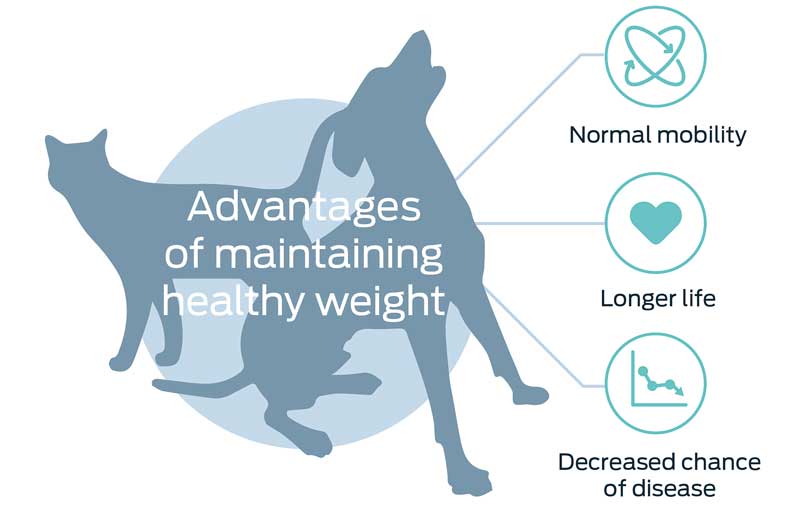10 Jan 2022
None of us are in any doubt. At the start of 2022, as a community of pet lovers, owners, pet care experts, veterinarians and suppliers, we all know that pet obesity is a serious problem...

None of us are in any doubt. At the start of 2022, as a community of pet lovers, owners, pet care experts, veterinarians and suppliers, we all know that pet obesity is a serious problem.
Roughly half of pets are currently overweight and obese. This is the number one health issue for pets – and it is only getting worse.
Maybe, this January it is time for us to focus our new year resolutions on getting our pet’s health and well-being on track where needed, and helping others to do the same.
Setting goals is the first step in making a change, but good intentions do not necessarily translate into action and we all know how difficult it is to sustain resolutions over the time. Indeed, nearly 50 years ago, Marlatt and Kaplan found that students who resolved to lose weight did not lose any more weight than students who did not form resolutions. No wonder that when we ask a pet owner to adopt new habits towards their loved companions as part of the weight loss journey there is a high chance of failure.
The critical question, therefore, is how to better support owners in the difficult journey of weight management – especially when routines and habits have been in place for years?
Perhaps the time has come for the veterinary profession to draw on the cumulative science of behaviour change, a study that is gathering momentum in other fields?
For the past five years, Purina, along with the University of Sheffield and other experts, have been working together to leverage expertise in public health, psychology and other fields to address this challenge. For example, we already know that we can learn from the public health sector, which differentiates between primary, secondary and tertiary prevention.
Primary prevention is about stopping a problem occurring. Secondary prevention is about steering away when a problem begins to appear. And tertiary prevention aims to prevent a problem getting worse and having further health impact.
For veterinary professionals concerned about overweight pets and obesity, this structure can be helpful. The three stages reflect pets in good health, pets starting to become overweight and pets suffering obesity. All stages could – and perhaps should – be associated with different interventions and approaches, with the goal of not only improving the pet’s health, but also supporting the owners in the change towards healthier and more balanced habits.
There are no one-size-fits-all solutions; rather, it is better to try to understand the different intervention strategies that work best across a range of scenarios. These insights are not fully available to us just yet, but by understanding the different situations, we can put ourselves in a position to better support owners.
So, how might behavioural science, which is at the core of Purina’s research with the University of Sheffield, help?
This is a study that is fast gaining traction – for example, the UN recently published a report on behavioural science – and a large number of studies have investigated how to change behaviour.
One outcome of all this research has been a taxonomy – or list – of 93 behaviour change techniques (Michie et al, 2013). While the sheer number of strategies attests to the possibilities offered by behavioural science, for a vet looking to help an overweight pet and its owner, this choice may seem overwhelming.
Luckily, there are ways to narrow down our approach.
One approach would be to tailor the choice of strategy to the particular challenge in question – something that is informed by the COM-B model (Michie et al, 2011).
The COM-B model proposes that behaviour occurs when people are (i) motivated, (ii) capable, and (iii) have an appropriate opportunity. In turn, the implication is that problems with behaviour (for example, not acting or acting inappropriately) may reflect a problem with motivation, capability (which refers to whether the person has the knowledge, skills and stamina needed to perform the behaviour), and/or opportunity (which refers to whether the physical and social environment support the behaviour).

So, people who feed too many treats to their dog may do so because they are not motivated to do otherwise (for example, they don’t think that obesity is a problem), because they are not capable of doing otherwise (for example, they use treats to control the dog and don’t have other ways of doing so), and/or reflect a problem of opportunity (the treats are in a bowl on the side, so the owner tends to just give the dog a treat as they walk past).
This framework can be combined with an approach called “intervention mapping” to choose behaviour change techniques that are best suited to tackling specific problems – for example, a person not feeling capable of getting a dog’s attention without treats.
Our objective at this time is to use these frameworks and models to develop applied research to understand the impact of each strategy and to build effective weight management programmes based on these insights.
This work is at an early stage, but we are accelerating and we are seeking support to do so. By identifying which strategies have the most impact, we will have the most chance of reversing the trend of pet obesity.
This year, perhaps our new year’s resolution should be to build a new evidence-based behavioural approach for helping pets and the people who love them.
To remain updated, contact [email protected]